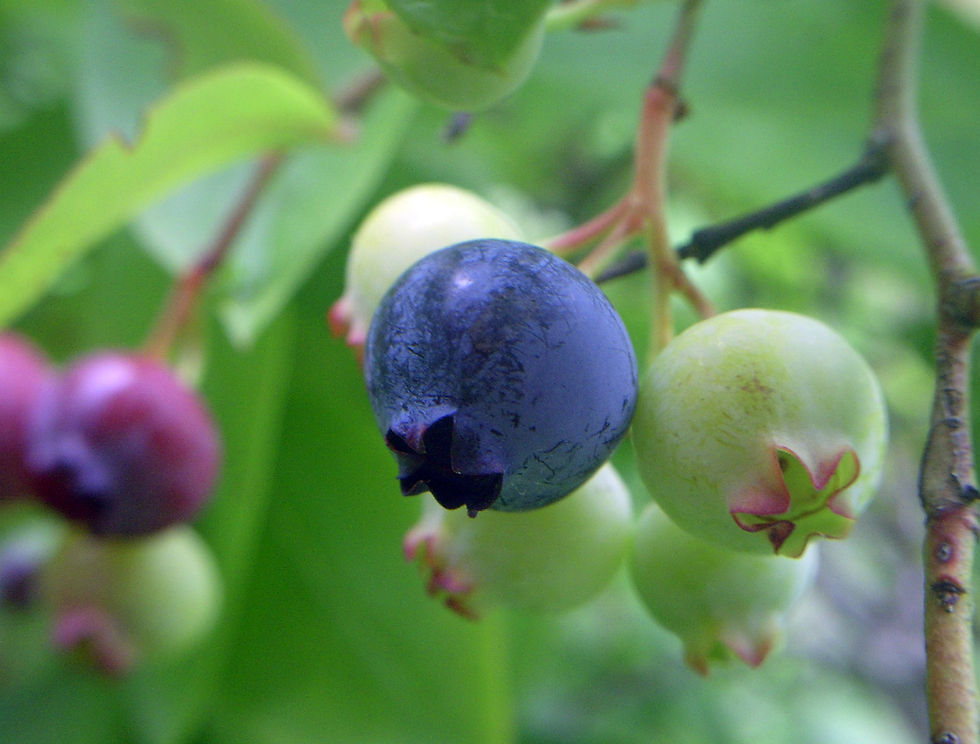Untwined – A Closer Look at Native Vines
- Jennifer Anderson

- Aug 20, 2023
- 3 min read
Updated: Dec 7, 2023

Summer blooms spilling over an evergreen hedge. Shade atop your trellis. A natural bird feeder.
Native vines do all of this and more. There are a lot of native vines out there. In this blog I’m focusing on the four we carry at Tree Talk Natives.
Serious but Showy
I first met Trumpet Vine, Campsis radicans, in the Adirondacks, where it grew up (and took over!) the light post just outside the kitchen window.
Who needs a bird feeder when you can watch hummingbirds dive into those glorious, 3-inch, orange-red, trumpet-shaped, late-summer blooms while wiping down the counters?
Trumpet Vine is the showiest of the native vines. Here on Massachusetts’ South Coast I see it spilling over sturdy evergreen hedges, showing off its beautiful blooms to all passers by. It has Very High pollinator values, feeding not just hummingbirds but also native bees, songbirds and butterflies and moths.
Trumpet Vine can get out of control, growing up to 30 feet a year, self seeding and sending out suckers. It is considered weedy in parts of its range, and small trees may struggle under the weight of this vine. You’ll probably want to prune this vine at least once a year to keep its growth in check.
Watch out if it starts up the side of your house. Trumpet Vine climbs by aerial rootlets, which can stick to siding.
For more on Trumpet Vine, check out this handy video.

Sun and Shade
If you’re after a profusion of beautiful, showy, fragrant, twining blooms, look no further than Virgin’s Bower or Old Man’s Beard, Clematis virginiana. Its creamy white blooms absolutely cover this vine for a month or more in mid- to late-summer.
The show is not over after the blooms fade. Feathery seed heads sprout all over in fall and somewhat resemble an old man’s beard.
Virgin’s Bower is one of the few native vines that will bloom in full shade, although it prefers some sun. Watch for butterflies, hummingbirds, native bees and other pollinators. It’s also a larval host to the Clematis Clearwing moth.
Virgin’s Bower grows fast and can gain up to 20 feet in a year. It climbs by twining itself around trellises, fences, posts and other plants.
It is resistant to deer, rabbits and black walnut, and it can be pruned almost to the ground in early spring.

Almost Perfect
The first plant I sold after moving my nursery to Massachusetts was Coral Honeysuckle, Lonicera sempervirens. Two more went in quick succession. No surprise – there’s a lot to love about this vine.
Its flowers are smaller than Trumpet Vine’s but still red and trumpet shaped and in fact a favorite of the Ruby-throated Hummingbird. Coral Honeysuckle also is a larval host for both the Spring Azure Butterfly and the Snowberry Clearwing Moth.
Like Virgin’s Bower it climbs by wrapping itself around support structures and is beautiful cascading over evergreen shrubs, trained along a fence or trellis or sprawling on the ground.
This vine blooms in late spring and persists, sometimes sproadically, into the fall. It blooms best in full sun and likes moist but well drained soil.
Coral Honeysuckle is considered deciduous but may be evergreen during a warm winter.

Foliage
Virginia Creeper’s leaves emerge purple in spring, and then after a green summer turn crimson and purple in the fall. Parthenocissus quinquefolia will grow in shade but colors best in full sun.
Like Trumpet Vine, Virginia Creeper climbs with tendrils that look like discs and will stick to just about any surface. Best to keep it away from the sides of the house and especially the gutters.
Gaining 30 to 50 feet a year, it works great as a ground cover and up trellises. Also a tree climber, Virginia Creeper provides shade and cover for little critters – all without smothering its host.
Blue fall berries are hard for us to see until the leaves drop – if there’s any left after the birds have their fill.
Virginia Creeper is a beautiful, native vine and at its best when it has room to roam. It grows easily but can be overwhelming. It responds well to early spring pruning, however, and, just like the other vines, can be cut back almost to the ground.
Sources
Ask Mr. Smarty Plants, Lady Bird Johnson Wildflower Center. https://www.wildflower.org/expert/show.php?id=7003
Barnett, T. Campsis Tree Damage – How To Remove Trumpet Vines From Trees. Gardening Know How.
https://www.gardeningknowhow.com/ornamental/vines/trumpet-vine/remove-trumpet-vines-from-trees.htm
Campsis Radicans. North Carolina Extension Gardener Plant Toolbox. https://plants.ces.ncsu.edu/plants/campsis-radicans/
Campsis radicans – Trumpet Creeper. https://gobotany.nativeplanttrust.org/species/campsis/radicans/#:~:text=Although%20the%20species%20is%20native,its%20aerial%20root%2Dlike%20holdfasts.
Lonicera sempervirens. Missouri Botanical Garden.
Lonicera sempervirens – Trumpet Honeysuckle. Native Plant Trust. https://gobotany.nativeplanttrust.org/species/lonicera/sempervirens/
Parthenocissus quinquefolia. Jersey Friendly Yards. https://www.jerseyyards.org/plant/parthenocissus-quinquefolia/#more
Parthenocissus quinquefolia. North Carolina Extension Gardener Plant Toolbox. https://plants.ces.ncsu.edu/plants/parthenocissus-quinquefolia/
Parthenocissus quinquefolia. USDA Plant Database. https://plants.usda.gov/home/plantProfile?symbol=PAQU2
Trumpet Creeper. USDA Natural Resources Conservation Services. https://plants.sc.egov.usda.gov/DocumentLibrary/plantguide/pdf/pg_cara2.pdf





Comments